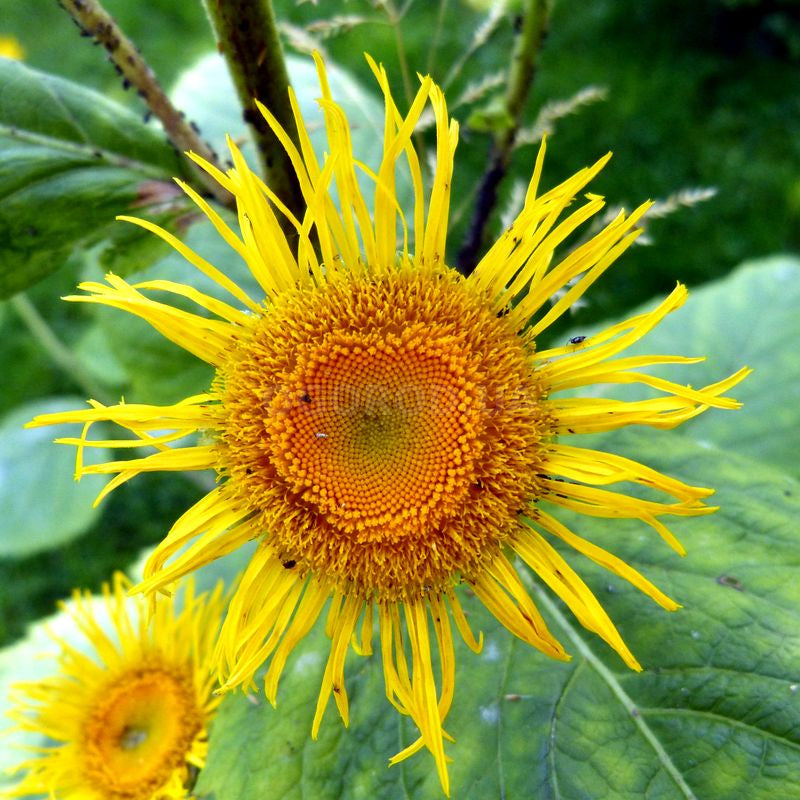Seedsua
Silphium seeds, 100 SILPHIUM PERFOLIATUM L.seeds, Organic heirloom SW144
Couldn't load pickup availability
SILPHIUM PERFOLIATUM L.
A perennial plant, unpretentious to soil and climatic conditions, has a long flowering time (up to 3-3.5 months) and good nectar productivity. The flower of sylphia intensively secretes nectar throughout the daylight hours. The medical productivity of sylphia is 500 kg / ha. This honey plant is characterized by stable nectar productivity over years.
Sylpha przonznolistnaya - a tall plant with a well-leafy large upright stalk, has flowers with a diameter of 2-3 inches, which are collected in inflorescences-baskets with flowers of two types: up to 33 fruiting female flowers in the form of reeds are located at the edges in two or three rows, and in the middle - tubular bisexual, but sterile flowers. Sylphia can rightly be considered the best honey plant of all herbs.
Honey yield sylphia (with an average density of 23 plants per square meter) is about 150 kg of sugar per hectare. Sylphia is a perennial herbaceous plant that can be grown in one place for at least 15 years, after which it must be moved to another place or always plowed or the soil recultivated under it, fertilized and planted again. As cultivation experience shows, sylphia grows well on moist and fertile soil, peaty marsh meadow soils, in floodplains of rivers, on the banks of irrigation canals and ponds, on apiaries, garden and vegetable plots, as well as in parks as a decorative plant. In these conditions in unshaded places sylphia in the second-third year of vegetation reaches a height of 3-3.5 m and blooms profusely. Sylphia should be sown in autumn 15-20 days before the onset of persistent frosts. In winter the seeds will undergo natural stratification in the soil, which guarantees good germination and creates the best conditions for an early start of vegetation and successful growth and development in the first year. Row spacing should be 0.7-1 m. This grass density produces a sufficiently large number of baskets with well-developed flowers. The depth of seed embedding is 1,5-2 cm. Autumn sowing gives very good results. Fallen seeds not embedded in the soil give early spring rapid sprouts. For spring sowing, air-dried seeds should be stored in a cool and dry place during winter. Before sowing they should be stratified, ie put for 1.5-2 months in damp sand and kept at a temperature of plus 3-5. Sow in early spring, as soon as the soil thaws.
In the first year, a rosette of leaves is formed. The stem develops in the second and subsequent years. Beginning in the second year, the sylphia blooms. Young sprouts tolerate spring frosts well, and rhizomes are cold-resistant.
If the sylphia plant is not used for fodder, the stem dries out in autumn at the end of flowering and full ripening of seeds, and it is cut off at ground level. For snow accumulation or windbreak purposes, the dried stems are left as waders for the winter and cut off in early spring, making room for new shoots.
Sylphia requires little care. During the first year of vegetation, two to three loosening of the row spacing and weeding should be done, in subsequent years - one loosening at the beginning of each summer.
Sylphsia is a valuable fodder plant, the yield of its green mass reaches 1000-1200 kg per hectare. The green mass can be used as fresh feed for livestock, as well as in the form of grass meal and silage.
The shipping cost includes a tracking number to track the order.



Review
It was so great to order for you. I can not wait to see what my seeds look like as flowers. Thank you. I will do business with you again!
-

Free Shipping
Pair text with an image to focus on your chosen product, collection, or blog post. Add details on availability, style, or even provide a review.
-

Gift
A gift to the most active customers.



